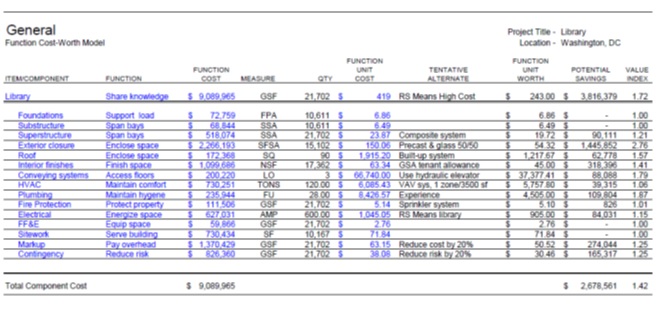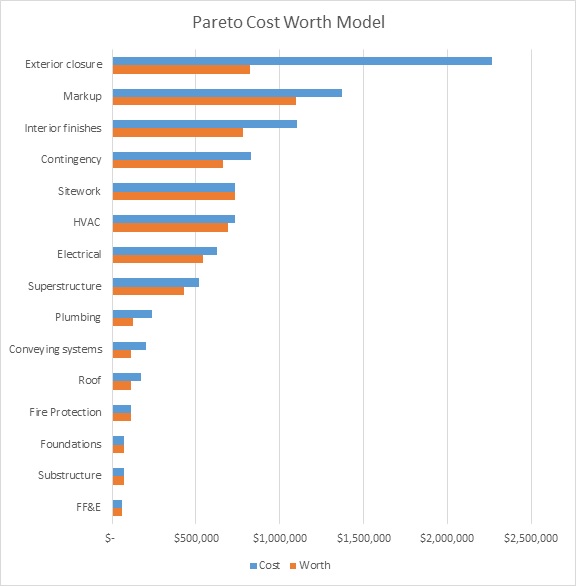By Donald Parker, PE, CVS
This is the second of my two-article series on use of my composite Cost-Worth model.
When one finds another product that costs less than the first product purchased to perform the function they wanted, then they are considering the worth of the function being acquired and assigning it a new value.
Determining Function Worth
Determining function worth is a key step in the VM process. It one of the essential ingredients in motivating teams to energetically recognize the value of their work. Larry Miles calls this mind setting. When it leads them to the potential and opportunity for improving value it is mind-tuning!
Always remember it is the user of the product that determines its value or worth. Not the designer, constructor, manufacturer, supplier or anyone else. Oh those folks all like to think they can tell you what is good value but only you, the user, can know what the cost of the function you are trying to obtain is worth.
Do not confuse the worth of products or systems with the worth of functions. To say what you think, for example, a screwdriver is worth would be presumptuous. You are on safe ground, however, to say what its function, “transmit torque” is worth.
Worth by our definition is the least cost that you know to provide a given function. You can determine the worth of a function based on your experience, historical data, cost manuals, benchmarking, or ask a team member or competitor.
In VM, worth is only associated with necessary function or functions of the present design of the item or system. The worth of a function is usually determined by comparing the present design for performing the function with other methods of performing essentially the same function on other products, services, or situations. The rule is: determine the cost of a functional equivalent based upon the way it was accomplished previously by someone else. To aid in determining worth, one might ask the following series of questions:
- What is the cost of achieving the basic function as the item is presently designed?
- Do you think the performance of the basic function should cost that much?
- If not, what do you consider would be a reasonable amount to pay for the performance of the function (assuming for the moment that the function is actually required) if you were to pay for it out of your own pocket?
- What is the cost of achieving this function if some other known item is used?
- Is this a common, easily accomplished function or one that is rate and difficult to achieve?
- What is the price of some item that will almost, but not quite, perform the function?
Aids to Determining Worth
Worth can be established at various stages of design or levels of detail. At the component level one could judge the least cost of the various functions provided by a door. For example, answer the questions: What is the least cost to — “seal opening.” “close door” and “lock door?”
At a budget level, one frequently has available historical parameter costs and can judge cost on such things as the cost per bed for a hospital, the cost per occupant for a school, the cost per judge for a courthouse, the cost per diner for a restaurant, etc.
Benchmarking is another technique often used to establish worth. People are always comparing prices for procurement of functions to see if they are getting the best deal.
Another useful technique is to take published historical experience and switch around normally used parameters to create statistics to expose, for example, the least cost of an office building on a cost per occupant basis. Casting a new light on foregone and accepted cost data often poses startling results.
For Library project discussed in my first article I used the UNIFORMAT code of accounts to establish function cost on a parameter basis. Now I’ll show you how to use these to determine function worth.
System Parameter Definition
Foundations FPA Footprint area in square feet
Substructure SSA Supported structural area in square feet
Superstructure SSA
Exterior closure SFSA Square foot of surface area
Roofing SQ Squares (100 sf each)
Interior work NSF Net square feet
Conveying systems LO Landing openings
Plumbing FU Fixture units
HVAC TONS 1 ton = 12,000 btuh
Fire Protection GSF Gross square feet
Electrical AMPS Connected incoming service load
Sitework ACRES
Utilities LF Lineal foot of each incoming utility
Markup PCT Percent of overhead & profit

Continuing the Value Study
As facilitator of the study you have just completed explaining the first half (the function cost creation) of this composite model. You have now arrived at the column “function unit cost” and are ready for the team to delve into function unit worth.
At Level 1, the Library itself, the team decided to find out what RS Means says about the gross square foot cost of a Library. The decided quickly that a Tentative Alternate would be to use the recorded high library cost of $243 per GSF as a worth for the function “share knowledge.” They decided to stick with a building cost and not delve into eliminating the building by use of other methods to share knowledge.
Next they started to work on Level 2 building systems to see if they could find out the major sources of opportunity for savings.
In the above example the team saw that the cost of the function “span bays” as $23.37 per SSA (square foot of supported structural area). They didn’t have a clue what system was actually in the design but they knew from a building of the height shown and its floor size that a composite system (concrete and steel) should only cost $19.72 per SSA. When they entered that number the spreadsheet calculated a potential savings of some $90 thousand dollars and a value index of 1.21 (21% of that component). Not bad for a quick mind setting.
I laughed when they picked the Tentative Alternative for interior finishes as what GSA would allow for a Tenant Finish Allowance they would use in a lease as their indicator of function worth to “finish space.”
Notice also they picked parameter numbers quickly from RS Means and the Plumbing worth parameter was based on one team member’s experience.
Selecting the Study Subjects
The above activity focuses the team on what to study. It motivates the team by letting them discover value improvement opportunities when there are none apparent prior to beginning the value study.
I guide the team to pick 3-4 with the highest value index. Normally these should provide for the easiest studies to do. These would be:
Exterior closure VI = 2.76
Plumbing VI = 1.87
Conveying system VI = 1.79
Library building itself VI = 1.72**
**Cautionary note – When you study the basic function of the whole project your goal is to create change in how the function is being performed. That means you’ll be eliminating the library building and “sharing knowledge” in another fashion.
I also guide the team to pick 3-4 of the highest potential savings. These would be:
Interior finishes $318,396
Markup $274,044
Superstructure $90,111
Electrical $84,031
Pareto Diagram
Some prepare a Pareto diagram arranging costs from high to low. See below.

This chart illustrates the highest cost items. It also identifies the worth. The difference between the two is the potential savings opportunity. I select the highest costs with the greatest cost savings potential for further study. The function “enclose space” (exterior closure) would be my first choice.
Mission Accomplished
Don’t be discouraged that most value studies don’t result in new inventions. They mostly result in redesign of the components of a given project, product or process.
And it has opened the door to the possibility that the project, product or process you are working on might be discarded for a new invention to achieve the function desired. Every time you open that door in your lifetime increases the probability that ultimate success will happen. I can only count on one hand the number of times a project I was working on was dramatically changed or cancelled because of function analysis rationale that it was not worth the cost.
Your effort to allocate cost to all functions and the team’s effort to judge the worth of those functions has put you on course to take advantage of the best opportunities to improve the value of the project being studied.
Finally, this is an excellent facilitation technique at the beginning of any study to promote mind-tuning that contributes to team successful output for a value study.
